The
IHP Pre-War PCC cars - Part II
***
Last issue, we evaluated the Imperial Hobby Productions (IHP) Ready-To-Run 87118A Pre-War St. Louis Car Co built Air-Electric PCC car. and, overall, we found it to be a great addition to a trolley modelers collection. We painted and lettered the car as Philadelphia Transportation Company 2508 in the late 1940's dress. HO scale traction modeler's should really appreciate the effort that IHP expended to provide a reasonably priced model of the Saint Louis Car Co. Air-Electric PCC car which can be used along with the ubiquitous Bowser All-Electric PCC car. Over 2,500 of these cars were produced between 1936 and 1944 for the majority of North American cities. Chicago, Kansas City, Los Angeles, Philadelphia, Pittsburgh, and Toronto all ran fleets of pre-war air-electric and post-war all-electric PCC cars together for many years. This month, we evaluated the kit version of the Pre-War PCC.
The kit consists essentially of a one-piece shell configured for the original 1936 Brooklyn version of the car with the two-section destination window, Brooklyn next car front dasher light, full length letter board fluting and the smaller anti-climbers. Provided in the kit are the original "bubble" trolley pole shroud, the full trolley pole shroud used on most cars after 1940, a set of leaf doors, a separate catcher casting, lifeguard fender trip mechanism, a set of "blinker" doors, a set of full size anticlimbers which were used on most cars after 1940, and a separate catcher.
IHP had to develop their own floor for this kit as the front platform and rear end are shaped differently from the All-Electric PCC. The floor represents the PCC underbody equipment and approximates the standard PCC truck wheelbase of 22' 9".
IHP provided very detailed instructions on assembling this car. This kit requires modeling skill and dexterity in using ACC type adhesives. There is considerable feathery flash in the windows, doors and along the skirts and detail parts. Some skill in using a modeler's knife is needed. Ensure that your blade is sharp and do not use too much force. Most of the flash flakes off when touched with the knife. The detail parts, especially the full width anti-climbers are very fragile and can be broken easily. We broke one of them ourselves when we bent it too much trying to attach it to the front of the car. Much care must be taken in securing them to the body in the right place using ACC type adhesives. IHP recommends a specific adhesive, Pacer ZAP-A-GAP, which we used with success. The floor casting seems to fit better inside the shell if the sides are sanded a little and the Bowser trailing truck turns much freer is the mounting boss is polished with a wire brush prior to installing the truck. One last item, if you intend to install a working headlight, a large portion of the front of the floor must be removed gain clearance for the headlight bulb. After reading this, if you do not feel comfortable with your level of skills in these areas, we recommend that you purchase the Ready-To-Run cars. There are four different models of these and most likely one of them will be right for the car that you wish to model. They are a great value. But at the price, this is great kit on which to increase your modeling skills.
To replicate the Philadelphia car, the model was painted using Floquil paint and lettered with Custom Traxx sets, CN-2001, CT-993B and CT-995. While the CN-2001 set gives most of the graphics needed to complete the car, the CT-993B set provides the maroon belt rail with one inch of cream striping on either side, eliminating difficult masking for a one-inch cream stripe. The CT-995 set provides both simulated bolt patterns for the resilient (cars 2001-2020) or super resilient wheels (all other Philadelphia PCC cars). Some readers have asked us how we handle the destination sign opening. The prototype PCC destination sign opening is 9" by 48" with rounded corners. So for these cars, we obtain a section of Evergreen StripStyrene #164, .080" x .080", trimmed it to snug fit the open destination sign box section, inserted it in the opening slightly behind the front of the opening, cemented it with ACC, installed the black destination sign background supplied in the CT-2001 decal set and then the destination sign of our choice
Anyway,
after working with three of these
models, we really like them and
we recommend them to traction modelers.
Maybe someday, we will try to make
a Los Angeles Railway P-2 PCC from
one of the kits.
_______________________________________________________
Modifying
the IHP Pre-War PCC Car
***
Last issue, when we evaluated the Ready-To-Run Imperial Hobby Products Pre-War PCC car, we mentioned a small inaccuracy about the shape of the front end. Since the release of the August issue of the Times, several readers asked us to clarify the issue and if we knew of a solution. We decided to address both questions in this issue.
Before we tackle the problem, we should mention that there have been white-metal kit versions (i.e. BEC), urethane shells (Q-Car), and at least three brass HO scale models (Soho, WP Car, MTS) of the 1936 Pre-War Air-Electric PCC car in the last twenty years and all of them had inaccuracies, some minor, some major. So this is in no way meant to be a criticism of the IHP model. Because of the resin casting, any inaccuracies in IHP model may be easier to correct. The widest part of the St Louis built PCC car is at the belt rail. Although most models replicated this feature in the sides and rear ends, they missed out a little on the front end next to the front door. This is most noticeable to those few of us who rode these cars when they were the "pride of the fleet" from 1938 to 1947 or operate them at the museums where they currently reside. Note the drawing below and the photo of Los Angeles Railway 3001. Note the slight curvature in the sides of the car between the two arrows. in the drawing. Also note the curved front doors, critical to the look of the model.
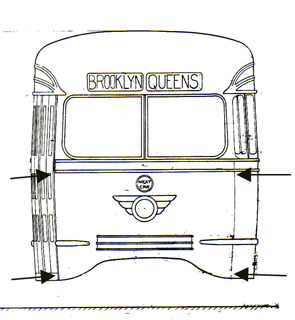
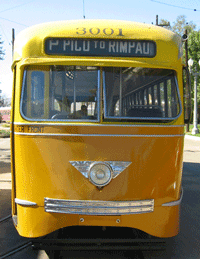
Some years back, a serious PCC modeler showed us how he had taken one of the brass Soho LARy PCC models mentioned earlier and, by making two minor cuts, some clamps and a resoldering effort, had improved the appearance of the front end. Since we have much more experience with resin and styrene kits than brass, we decided to try this experiment with the IHP car. Since IHP has so graciously provided a reasonably priced kit, this is the one with which to take chances, assuming that, if we were unsuccessful, we could obtain another shell from IHP.
[cont'd Column 2]
_____________________________________________________
Another
New Orleans Car
for San Francisco
During the weekend of August 27-28, former New Orleans Public Service car 913, a long time resident of the Orange Empire Railway Museum, had its tarp removed, one trolley pole installed and was motored from its storage track around the museum for one last trip by veteran museum member Dave Garcia. Below is a photo of car 913 on it's last Southern California run on Saturday, August 27, 2005.
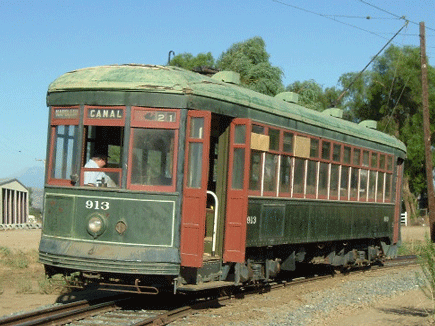
The car was then loaded on a flat-bed truck and left the museum late Saturday evening for its journey to San Francisco, where the car will be refurbished and eventually used on San Francisco's F line. It joins sister car 952, which has been running in San Francisco for a few years now. Both cars were originally built by the Perley-Thomas Car Co in 1923-1924. Car 913 was one of the first non-California cars acquired by the Orange Empire Railway Museum and was a main-line favorite in the early 1970's. Many museum motormen trained and qualified on this car, including Custom Traxx owner, George Huckaby. Car 913 is the fourth car provided to San Francisco Municipal Railway by the museum in the last few years.
[All photos graciously provided by Karl Johnson]
Southern
California Traction Club Featured
in Railmodel Journal!
***
To
the surprise and delight of the
membership, the modules of the Southern
California Traction Club were featured
in the June issue of Railmodel Journal.
Photographs had been taken at the
iHobby Expo in Las Vegas in October
2004. There were some very good
photographs taken at that time and
so if you missed them, you might
want to grab a copy of the magazine.
___________________________________________
New
Decals Coming
from Custom Traxx
***
Trolleyville just learned that Custom Traxx will be releasing two sets of decals that will have interest to Philadelphia area trolley modelers. In an interview with Custom Traxx, we were told that they had decided to release one decal set for both the Philadelphia Suburban Trans'n Co. 80 series (77-86) 1932 Brill cars and the St. Louis Quasi-PCC (11-24 series cars) a second set for the Center Door Cars (45-76 series) prior to the end of the year.
Custom Traxx has planned to release a decal set for the Philadelphia Suburban Trans'n Co Brilliners (1-10 series) concurrent with the release of the MTS Imports, Inc HO scale model. But this model has been delayed for almost five years and customer demand prompted this decision. Check the Custom Traxx catalog for more details including content and the availability dates.
_____________________________________________
[Cont'd from Column 1, IHP PCC]
The procedure does require some modeling skill and it is suggested that you try this with an old Bachmann PCC shell prior to attempting this. The correction consists of using a razor saw to make two vertical cuts on each side of the front windshield in the dasher to a point one scale foot below the belt rail. The cut on the left dasher is shown below. Note that the cut is slightly wider at the skirt level to produce the effect that we want. NOTE: This was our first cut and it was made wider than needed. A narrower cut as shown in the second cut is sufficient.
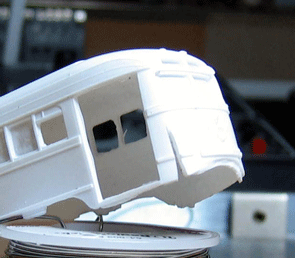
We corrected the cut made above; pressed the shell together at the skirt level; applied ACC; filled in the crack with Squadron Products Fast Drying White Putty and carefully sanded the dasher smooth. We then made the second cut as shown below.
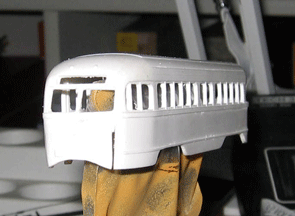 Note
that we have already acquired the
desired curve in the left dasher
where we made the first cut. After
pressing the shell
together at the skirt level; applying
ACC; filling in the crack with Squadron
Products Fast Drying White Putty
and carefully sanding the dasher
smooth, the front end of the car
appeared as below. This in our opinion
is a dramatic improvement. Of course,
since the front end is now slightly
narrower than before, a little of
the floor around the front end needs
to be removed in order that the
shell fit correctly. A little sanding
with a file and a sanding stick
did the trick here.
Note
that we have already acquired the
desired curve in the left dasher
where we made the first cut. After
pressing the shell
together at the skirt level; applying
ACC; filling in the crack with Squadron
Products Fast Drying White Putty
and carefully sanding the dasher
smooth, the front end of the car
appeared as below. This in our opinion
is a dramatic improvement. Of course,
since the front end is now slightly
narrower than before, a little of
the floor around the front end needs
to be removed in order that the
shell fit correctly. A little sanding
with a file and a sanding stick
did the trick here.
Since we were working so much with the shell, we decided to model the 1942 Philadelphia PCC cars, series 2081 to 2090 and 2581 to 2680. The distinct exterior feature of these cars is the absence of any curved side fluting on the front and rear of the cars, leaving only two horizontal ribs above the main body windows. These were removed with careful, slow, continuous sanding. In the process of removing the Brooklyn/Boston next car light located above the headlight, we chose to sand the dasher smooth, eliminating the cast on headlight wings. We replaced them with decal headlight wings contained in the CN-2001 or CT-995 decal set. When finished, we liked the look of the revised front end. Shown below is the unmodified PTC 2508 (left) and the modified PTC 2671 (right) for your comparison.
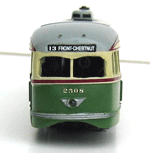
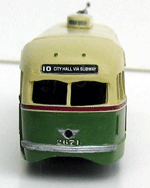
There
are some actions that we took during
assembly of the kit that we will
pass on to you.
1. We drilled out the body shell
mounting holes in the floor with
a #47 drill prior to placing the
shell on the floor.
2. We used a #53 drill to drill
out the body mounting bosses and
tapped them to to accept the 1-72
screws provided.
3. Since the IHP floor is thicker
than the Bowser floor, the screws
provided with the Bowser 125100
are barely long enough to secure
the motor mounts. We countersunk
the bottom of the floor to allow
the screws to get a better grip
in the Bowser motor mounts.
Shown below are the three of the IHP Pre-War PCC cars under testing at the test track of the Southern California Traction Club. From left to right are cars Philadelphia cars 2534, 2508 and 2671.
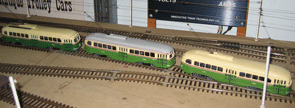
Again,
we are having a great amount of
fun and have expanded our modeling
skills with these new Pre -War PCC
cars and kits from IHP and highly
recommend them. We only hope that
you will enjoy them as much as we
have.
____________________________________________
[cont'd from Col 1 - Another New Orleans Car]
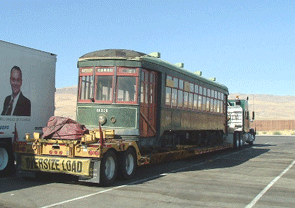
On it's way to San Francisco - August 28, 2005
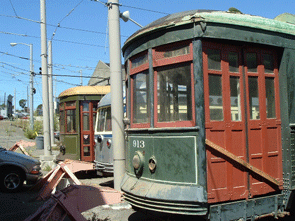
In Geneva Yard with 952 - August 29, 2005